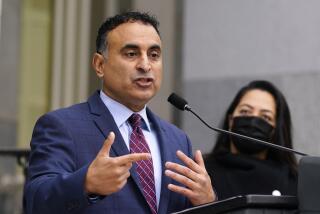Editorial: One thing the U.S. government doesn’t count: How often police kill civilians

- Share via
The federal government amasses statistics on a wide range of topics. Want to know how many people contracted botulism? How many kids participated in extracurricular activities? How many acres of corn are planted in a given year? It’s all tracked.
But one thing the government doesn’t count, as was spotlighted this summer amid the fallout from Michael Brown’s shooting death in Ferguson, Mo., is how often police kill civilians. The “Death in Custody Reporting Act of 2013,” passed last week by Congress and awaiting President Obama’s signature, would begin to address that shortcoming. It would make it mandatory for local law enforcement agencies to report on such shootings, reviving a requirement that lapsed in 2006. Though the government has continued to collect some data since then, the reporting by local police agencies has been voluntary and, experts say, incomplete.
The new law would require police to report the name, gender, race, ethnicity and age of the shooting victim, as well as provide a brief description of the incident. But as the title says, the act covers only deaths of people in custody — from the arrest process to state prison. Brown’s death, for example, would not have been required to be reported under the law because he was not in custody. That’s a pretty big hole in the law; common sense suggests that police shootings often involve people who are not yet in custody, including people, for instance, who are running away. So even now, the federal government still won’t know the full scope of the problem. (The White House’s recently established Task Force on 21st Century Policing is considering recommending that all officer-involved deaths be tracked.) Another problem: The act requires collection of demographic details on victims, but not on the law enforcement officers involved.
Police are crucial in our communities; they play a vital role in enforcing laws and keeping the public safe. But based on persistent reports of excessive force, it’s clear that some officers shoot too quickly, are susceptible to bias in confronting minorities and, in some cases, wind up killing unarmed people who posed no existential threat — and in some cases were committing no crimes.
But how often that happens is just guesswork. The FBI compiles statistics from 18,000 law-enforcement agencies for its annual “Crime in the United States” report, but it doesn’t include “use of force” data. Separately, the bureau collects voluntarily supplied data on “justifiable homicide” by police, defined as “the killing of a felon by a law enforcement officer in the line of duty.”
Most police departments already maintain “use of force” reports for their own analyses and personnel reviews, so these statistics are obtainable (some agencies, including the Los Angeles Police Department, post summaries on a website). If the federal government believes that black lives matter, to borrow a phrase from the current protest movement, one way to show it would be by counting how often African Americans — and all other Americans — are killed by police. And then craft policies to address it.
Follow the Opinion section on Twitter @latimesopinion
More to Read
A cure for the common opinion
Get thought-provoking perspectives with our weekly newsletter.
You may occasionally receive promotional content from the Los Angeles Times.






